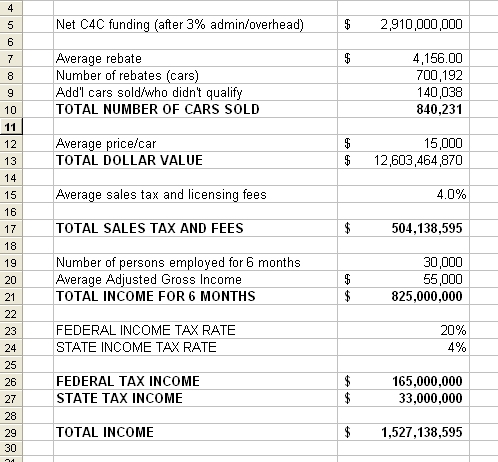The Car Allowance Rebate System (CARS) (popularly known as Cash for Clunkers or C4C) is one of the few Federal stimulus programs targeted at average workers and consumers. Does it work? You be the judge. This is not a political blog, so I’ll try to refrain from any ideological pronouncements. Instead I’ll offer my analysis as a spreadsheet jockey and business manager.
 In a nutshell, Cash for Clunkers (C4C) offers rebates to vehicle (car, small truck, and SUV) buyers when they trade in older models that get significantly worse gas mileage than the new ones they purchase. I don’t need to recount the rules for you here, other than to say that rebates are offered in two tiers, $3,500 and $4,500. You get more money when you buy a vehicle with better gas mileage.
In a nutshell, Cash for Clunkers (C4C) offers rebates to vehicle (car, small truck, and SUV) buyers when they trade in older models that get significantly worse gas mileage than the new ones they purchase. I don’t need to recount the rules for you here, other than to say that rebates are offered in two tiers, $3,500 and $4,500. You get more money when you buy a vehicle with better gas mileage.
Congress funded C4C in two rounds, an initial billion bucks, and another $2B when the first billion ran out. Critics decry C4C as a transfer of taxpayer money to the unworthy. They also question the wisdom of enticing economically marginal consumers into new loans. Proponents defend C4C as both an environmental boon that will reduce fuel consumption and greenhouse gas emissions and an economic stimulus to keep car companies, parts suppliers, and dealers in business.
Whichever side you’re on, you’ll spin my numbers to serve your argument. So have at it. Here are some numbers. In some cases, they’re wildly guesstimated, but close enough to be worth arguing.
- The government funded C4C with $3B. With 3 percent administrative overhead, that’s $2.91B net.
- Dealers report that most buyers qualify for the $4,500 rebate. So, I calculated the average rebate at $4,156.
- Consequently, I estimated that C4C resulted (or will result) in 700,248 new vehicles being sold.
- Dealers also report that many buyers who didn’t qualify for rebates go on to buy a new or used vehicle anyway. Let’s say that represents an additional 20 percent on top of the total C4C vehicles sold, or 140,050 vehicles.
- If we peg the average cost/vehicle at $15,000 (net after rebate), you get a total of $12.6B in economic “stimulus.” This doesn’t account for other revenues associated with a new vehicle purchase, such as insurance and accessories.
- In turn, that $12.6B generates state and local sales taxes, as well as vehicle license and registration fees. I estimate the average rate is 4 percent, making the total local and state sales tax take $504M.
- If the program keeps employed for six months 30,000 car dealers, manufacturers, assemblers, parts suppliers, and lenders who have an adjusted gross income averaging $50,000 annually, the program generates another $750M in personal income. That income then generates $150M in Federal income taxes (based on a 20 percent rate) and another $30M in State income taxes (using a 4 percent rate).
With Cash for Clunkers, workers stay employed and get a fleet of new more fuel-efficient vehicles. The economy gets a $12.6B cash infusion, and the States and the Federal government get $1.53B back in direct return. If we wanted to take this analysis a few steps further, we could also analyze:
- the reduction in gas tax revenue
- the gain in sales tax to local economies as a result of keeping workers employed
- the gain to State and Federal governments by avoiding payment of unemployment benefits
Knock yourselves out. I’m interested to hear opinions on how to improve my numbers, but there’s no need to shout. Pick your own numbers and do your own math.

Update 1: The U.S. Department of Transportation has confirmed my numbers, reporting on August 26, 2009 that Cash for Clunkers resulted in 690,114 vehicles sold (off only 1.5 percent from my projection), resulting in $2.878 billion in rebates or an average of $4170 per rebate (both about 1 percent of my projections).
References
Car Allowance Rebate System (CARS) at Cars.gov (official site) – Now only on Archive.org
CARS Statistics Page – now only on Archive.org
Cash for Clunkers Car Buying Stimulus Program (Edmunds.com, Aug. 17, 2009)

3 thoughts on “Cash for Clunkers Drives Big Returns: Updated”
Today the government reported that it sold 690,114 cars, which means that I projected the result within 1.5 percent.
http://news.yahoo.com/s/ap/20090826/ap_on_bi_ge/us_cash_for_clunkers
Hi Dave
It seems to me that the figures show a good return on the funds. Would you be bale to include the economic benefits of the program such as the savings created improving air quality due to reduced fuel consumption, oil not burnt by the new motors. Won’t the reduced fuel consumption help lower the national debt?
Who, by the way, are the “unworthy”?? People on lower incomes are generally burdened by having to buy older vehicles that burn more fuel and oil. The 30% of the US workers who earn the low hourly rate are stuck there because they have no other option. Are they unworthy because they cannot buy a new vehicle unaided?
Whatever happened to “all men are created equal”? Didn’t the finance industry just receive a multi-billion cash injection – a government handout?
The effect of the $3B injection will go on for some years, especially as it creates stability.
As a side question, when the government gave those billions to the finance industry, did those banks then continue to pursue those people defaulting on those loans that they shouldn’t have written anyway? Now you have banks with cash but cities with many empty homes that are deteriorating as an asset. Why not help those who lost jobs because the mess the finance lot created and pour in funds to either reduce the loans to a manageable amount or give them loans at a low rate? That way you get greater stability by keeping people in their homes, and assets that will appreciate.
Thanks for your comment David. I thought about trying to quantify savings from cleaner air, but decided to leave that for the economists out there. My gut feeling is that there may be unintended consequences, for example, car owners may drive more miles in their new vehicles than they did in their clunkers, obviating any environmental advantage. Also, reducing fuel consumption reduces gas tax revenue. Gas taxes pay for highway infrastructure, and in some cases they’re paid into the states’ general funds. Reducing fuel consumption may help lower the national debt, but (it seems to me) only if it allows the U.S. to draw down its military presence in oil-producing regions. But then again, look at our Cold War lesson. We won. The communist threat evaporated, but our military expenditures just continued to soar.
Comments are closed.